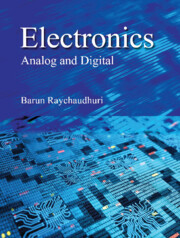Book contents
Summary
As understood from Chapter 5, the bipolar junction transistor is a current amplifier of its own. However, it can be made to amplify voltage also, as will be discussed in this chapter. The key factor for voltage amplification with transistor is the use of external passive elements such as resistors and capacitors in the transistor circuit driven by a single voltage supply. The process is termed as biasing. This chapter illustrates several popular biasing techniques for the common-emitter (CE), common-base (CB) and common-collector (CC) configurations of the transistor.
Load Line and Q-Point
The concept of operating point and load line has been introduced in Chapter 4 in connection with p–n junction diodes. Similar requirements of tracing load line and establishing operating point are realized with the transistor also. The convention remains the same, but the parameters get changed in the case of a transistor.
The operating point for a transistor is commonly named as the Q-point or the quiescent point because it specifies the output voltage and the output current at which the transistor operates steadily. The Q-point of a particular transistor circuit is determined by establishing proper voltage levels at the three terminals using the voltage drops across external resistors, capacitors or inductors and a single electrical power supply. This process is known as biasing, to be discussed in the next section. The fixation of Q-point depends on several factors, such as
• the dc and dc loads of the amplifier,
• the range of the power supply,
• the maximum power rating of the given transistor and
• the allowable distortion in amplification.
Based on the above, there are several different types of classifications of amplifiers, namely class A, class B, class AB, and class C, to be discussed in Chapter 8. In practice, the Q-point of a transistor is determined with reference to output characteristics in the following way.
Figure 6.1(a) shows an n–p–n transistor in CE configuration with an external resistor (RC) in series with the collector terminal. The output characteristics for different base current are sketched in Figure 6.1(b). These are similar to Figures 5.4 (a) and (b), respectively, of Chapter 5 but there is an important difference.
- Type
- Chapter
- Information
- Electronics , pp. 163 - 199Publisher: Cambridge University PressPrint publication year: 2023



